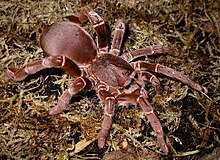|
King baboon spider
Pelinobius or the king baboon spider[citation needed] is a monotypic genus of east African tarantulas containing the single species, Pelinobius muticus. It was first described by Ferdinand Anton Franz Karsch in 1885,[3] and is found in Tanzania and Kenya.[1] DescriptionThe king baboon spider is rusty brown to orange in color. They live in the shrublands and grasslands of east Africa, often using vegetation as a protective cover for their burrows. They are one of the few tarantulas that use stridulation as a major defense mechanism in addition to rearing up and striking. They produce the stridulation-sound-effect by rubbing the femurs of their first and second pairs of legs. They are a slow-growing species, but can reach a leg span of up to 20 centimeters. They are burrowing-spiders with thick back-legs used for digging. They generally hunt beetles, cockroaches, and other spiders, and they will put silk near the entrance to its burrow to detect vibrations of passing prey. In captivityThey are popular among collectors, but they tend to be highly defensive, lacking urticating hairs, and are not suitable for beginners. They have very strong venom and their bites are extremely painful, though they are not known to be deadly to humans. A bite from a smaller spider will cause sharp pain and localized itchiness for five days.[4] Adults can be kept in a converted aquarium if given plenty of ventilation and a substrate at least 25 centimeters deep. Younger spiders can be kept in small containers, such as pill- and waxworm-tubs, but will need deeper containers as they grow.[4] See alsoReferences
|
||||||||||||||||||||||||||||||||||
